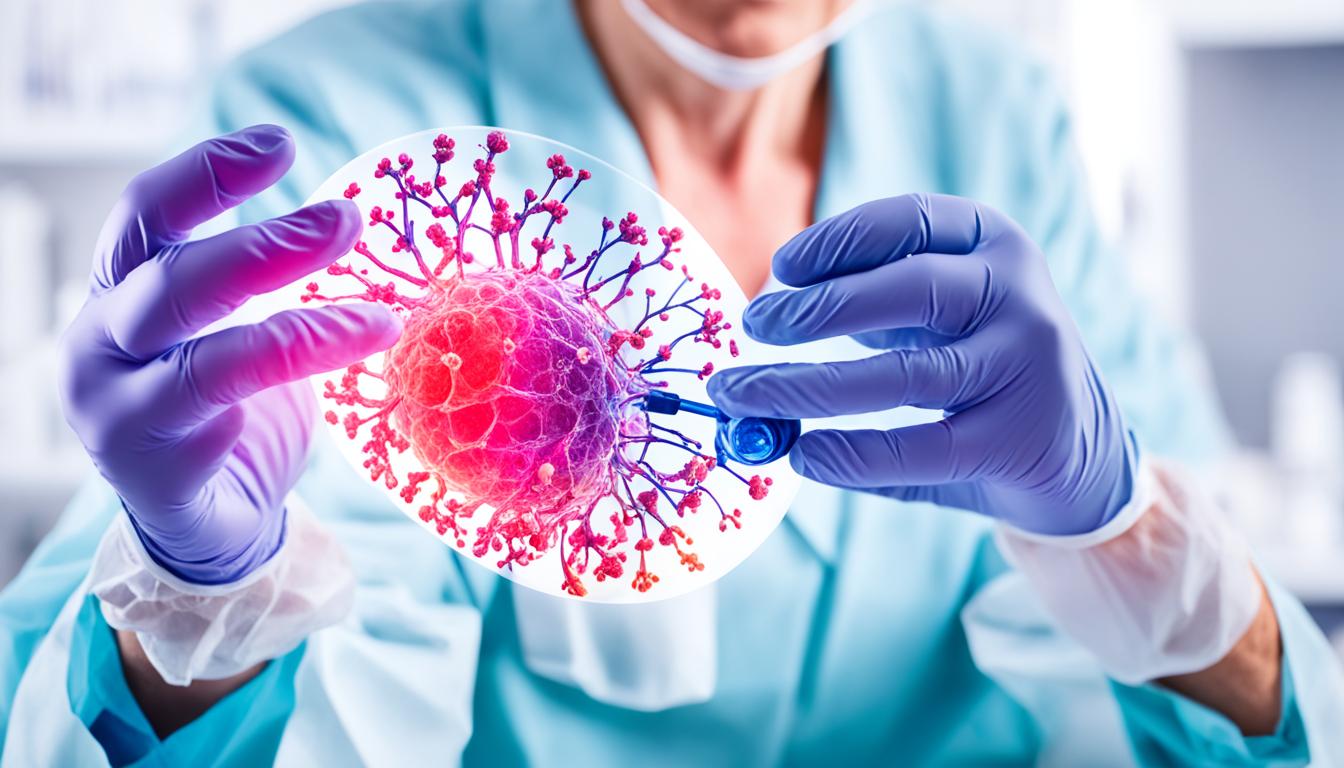Congenital diaphragmatic hernia (CDH) affects newborns and is serious. It happens when organs push through a hole in the diaphragm. This causes the baby’s lungs not to develop well, leading to breathing issues. In the UK, about 1 in 5,000 babies are born with CDH.
If a baby has CDH, they will likely need surgery. When this surgery happens depends on how stable the baby is and their heart and lung health. Luckily, the chances of survival for babies with CDH have increased. Now, 7 out of 10 babies with CDH survive.
Currently, surgery is the main way to treat CDH. But, there is exciting research on using stem cells. Stem cells can become many types of cells, including lung cells. This suggests they might help fix or regrow the lungs of babies with CDH.
Key Takeaways:
- CDH is a serious condition that occurs during pregnancy, causing underdeveloped lungs and breathing difficulties in newborn babies.
- Around 1 in 5,000 babies born in the UK are affected by CDH.
- Surgery is necessary for all babies with CDH, and the timing depends on their stability and the strength of their heart and lungs.
- Advancements in CDH treatment have significantly improved survival rates, with 7 in 10 babies now surviving.
- Stem cell therapy is being studied as a potential breakthrough treatment for CDH, offering the possibility of repairing damaged lung tissue.
Diagnosis and Antenatal Care for CDH
Diagnosing CDH (Congenital Diaphragmatic Hernia) is key for proper treatment. It can be seen on normal scans before birth or if the baby has trouble breathing after they’re born. These scans are crucial. They help find CDH early, so medical teams can give the right care right away.
For CDH, extra tests are done to see how serious it is. They check the baby’s lungs, heart, and if there are any chromosomal problems. Getting detailed tests early helps doctors plan treatments that fit each baby’s needs best.
If CDH is found during pregnancy, the mom’s care moves to a special clinic. This clinic, called FANS, is a place with many experts. They work together to watch over the mom and baby closely, ensuring they get the best care.
CDH Scans: Ensuring Accurate Diagnosis
Antenatal scans, like ultrasounds, are vital for finding CDH early. They let doctors see the baby and check for any problems, including hernias.
In these scans, doctors look at the baby’s diaphragm and stomach area. This helps them find out if there’s CDH and how bad it is. Quick and accurate spotting of CDH is crucial for starting the right treatment.
Routine Antenatal Scans: A Crucial Component of CDH Care
Having regular antenatal scans is very important for checking the baby’s health and growth. They help doctors spot issues early and figure out the best actions to take.
These scans also let doctors see how the baby is doing. They check on the baby’s heart, movements, and how well the cord is working. This information guides treatment and helps ensure a healthy delivery.
Doing these scans as part of CDH care lets doctors keep a close eye on the baby’s health. It helps them make smart choices and support the mom and baby as needed.
Dealing with CDH during pregnancy is hard, but early detection and good care can make a big difference. Scans and places like FANS are key. They offer the necessary help for CDH, making the pregnancy journey safer for both mom and baby.
Treatment and Surgery for CDH
Treating CDH is complex and uses many techniques to improve the baby’s breathing and oxygen levels. The main aim is to let the baby breathe comfortably by using a CDH ventilator. This device is key for better breathing.
A CDH ventilator helps the baby get a mix of gases and more oxygen directly into their lungs. It makes their lungs work better and eases their breathing problems from CDH. It also makes sure the baby’s breathing system stays stable.
For some, a softer ventilation method, called oscillation, is better. It uses gentle, quick vibrations to boost the baby’s lung function and can lower the need for stronger ventilation.
If a baby is really struggling, an ECMO machine might be used. ECMO helps when the baby’s heart and lungs can’t work well. It takes over their breathing for a while.
After the baby is stable, they usually have CDH surgery. Surgery puts the organs that pushed into the chest back where they belong. It also fixes the hole in the diaphragm.
The right time for surgery is important. Doctors decide based on the baby’s health, and if their heart and lungs are strong enough. It’s usually done when the baby’s breathing system is well developed.
CDH surgery’s success depends on several things like how skilled the surgeons are and the baby’s health. After the surgery, the baby needs careful watching and care for a good recovery.
Conclusion
The future for babies with Congenital Diaphragmatic Hernia (CDH) varies based on its seriousness. This includes if there are other complications too. Some common issues are hernia coming back, stomach acid going up into the throat, trouble with breathing, and hearing problems.
Babies with small hernias usually have a better chance. But, new studies and better treatments offer hope for all CDH patients. For example, stem cell therapy might be a big step forward in fighting CDH.
Doctors are always looking for new ways to help these babies. The main goal is to make sure they have a good life in the long run. This means tackling problems early, using the best medical knowledge, and trying out new treatments.

